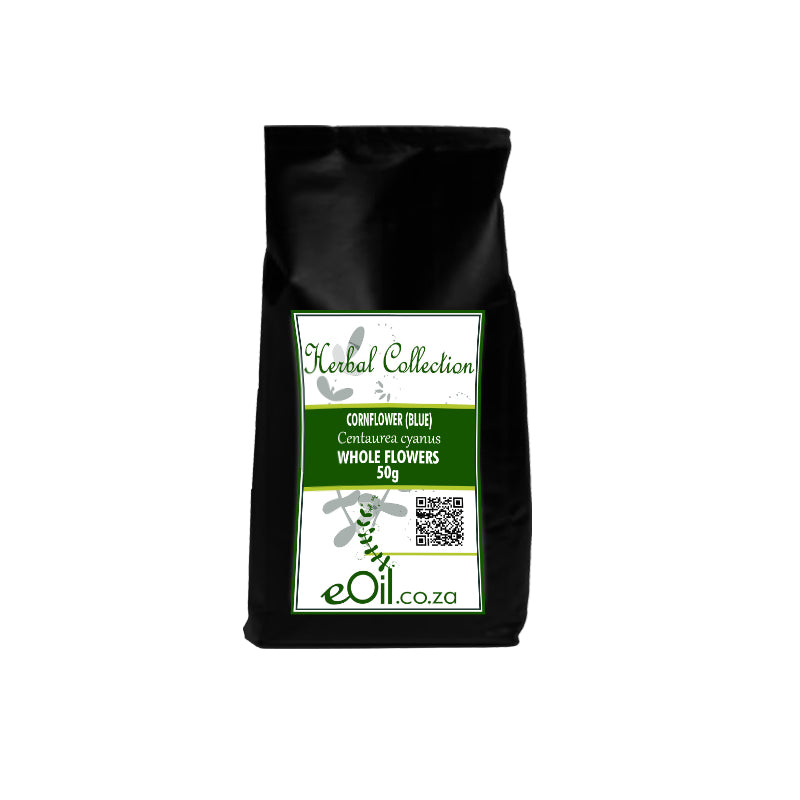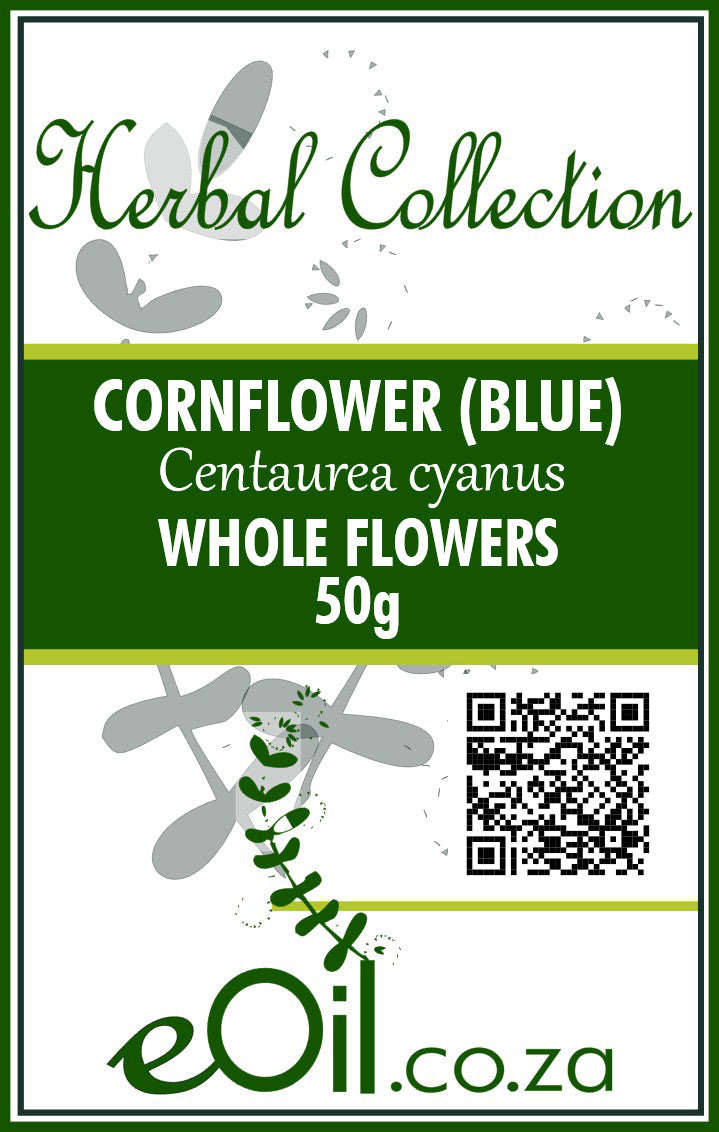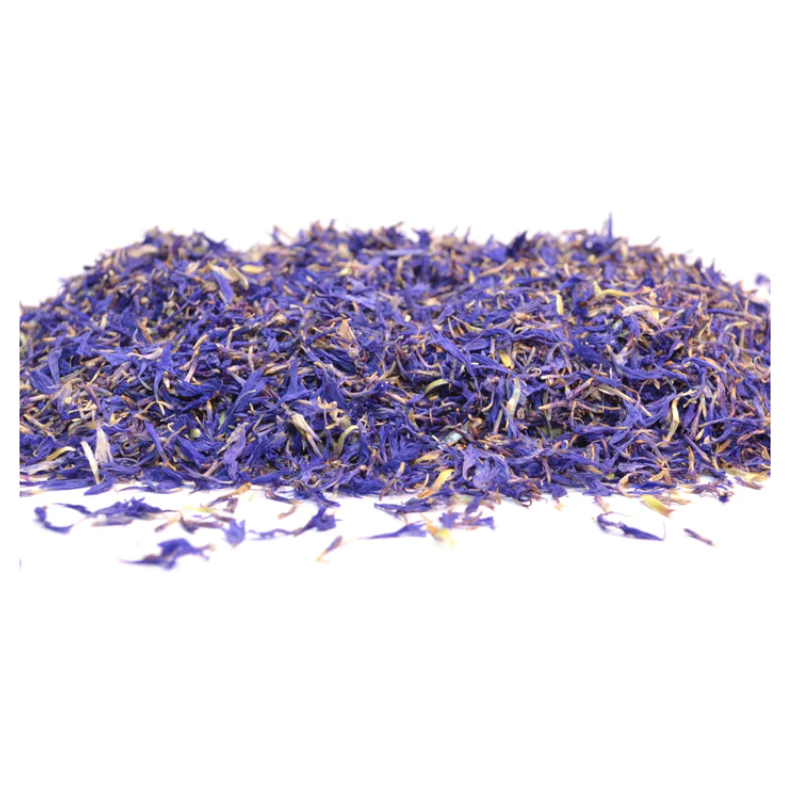Cornflowers Blue Whole - Herbal Collection
Cornflowers Blue Whole - Herbal Collection - 50 GR is backordered and will ship as soon as it is back in stock.
Description
Description
Corn flowers Blue Whole (Centaurea cyanus) are delicate, vibrant blue petals traditionally prized for use in herbal teas, infusions, and natural skincare blends.
Known for their subtle, earthy flavor and striking color, these dried blossoms are perfect for creative culinary presentations, crafts, and natural beauty rituals.
100% pure and naturally dried—no additives
TRADITIONALLY USED FOR
Premium Whole Blue Cornflowers: A Vibrant Herbal Remedy, Wellness Tea, and Culinary Accent
Corn Flowers Blue Whole from eOil.co.za’s Herbal Collection are hand-selected, all-natural dried blue petals of Centaurea cyanus, cherished for both their aesthetic beauty and wellness support
Renowned for a gentle, floral flavor, blue cornflowers are a premium addition to teas, natural remedies, and gourmet creations.
Product Features
Corn Flowers Blue Whole (Centaurea cyanus)
100% pure, food-grade, vegan-friendly, naturally dried petals
Premium blue herbal tea flower for colour, wellness, and culinary use
Antioxidant, diuretic, digestive-supporting, and gentle anti-inflammatory
South African trusted source for dried edible flowers
Key Benefits & Traditional Uses
Antioxidant & Cellular Support: Rich in anthocyanins and flavonoids, cornflower petals protect against oxidative stress, helping to reduce chronic disease risk and support overall wellness.
Digestive & Detox Benefits: Traditionally used to ease digestive discomfort, reduce bloating, and gently stimulate the body’s natural cleansing processes through mild diuretic effects.
Anti-Inflammatory: Blue cornflowers provide mild, natural anti-inflammatory action, soothing minor inflammatory ailments internally and externally (e.g., tea compresses for eye irritation).
Eye & Skin Soothing: Used as an herbal eyewash and in beauty routines to calm irritated or tired eyes, and to soothe skin irritation.
Calming Nerves: The tea is cherished for its gentle, relaxing effect, making it helpful for reducing stress and supporting restful sleep.
Culinary Accent: Adds brilliant blue colour and mild floral taste to salads, baked goods, cocktails, and herbal tea blends.
Basic Certificate of Analysis (COA) Information
Botanical Name: Centaurea cyanus (blue cornflower)
Form: Whole dried blue petals
Phytochemicals: Rich in anthocyanins (blue pigment), flavonoids, phenolic acids, tannins, sesquiterpenes, and biotin
Quality: 100% natural, hand-harvested, food grade, free from additives, vegan-friendly
Microbial/Safety: Batch-tested for purity and low in contaminants
Shelf Life: Store in a cool, dry, sealed container away from direct sunlight to preserve colour and aroma
Instructions for Use
Herbal Tea/Infusion:
Add 1–2 teaspoons of whole dried petals to a cup of boiled water
Steep 5–10 minutes, strain, and enjoy (up to 3 cups per day)
Pairs well with chamomile or peppermint; can be served hot or iced, with optional honey or lemon
Culinary:
Sprinkle petals on salads, cakes, desserts, or cocktails for colour and appeal7
Use in beauty, soap, and DIY bath products as a natural colourful accent3
Other Traditional Uses:
Herbal eyewash: Brew a tea, cool, and use as a gentle compress for irritated eyes
Hair and skin care: Add to homemade lotions and rinses for soothing properties
Storage:
Keep in a sealed, dry container, away from light and moisture. Colour fades over time, but petals remain safe and usable when kept dry.
Cautions & Safety
Generally recognized as safe for food and beverage use; limited data, but no known issues for pregnancy or breastfeeding in typical culinary amounts
Always purchase food-grade petals if used for culinary or herbal tea
Discontinue use if any allergic reaction occurs
Disclaimer: For educational purposes and general wellness. Cornflower is not intended to diagnose, treat, cure, or prevent any disease. Consult a healthcare provider for personalized advice—especially if pregnant, nursing, or using for medicinal purposes.
INFORMATION
Source : http://www.wikiphyto.org/wiki/Bleuet
Reference on http://www.wikiphyto.org
Translation in English by Google Translate (go to the page of the source linked | on Chrome cellphones go on the 3 dots on the top right and select translate in your preferred language | on laptop right click your mouse and select option translate when hoovering on the page
plant name
Cornflower , cornflower , bezel breaker
International Latin denomination
botanical family
Asteraceae
Description and habitat
- Branched annual or biennial herbaceous plant, frank green leaves, more or less deeply divided depending on whether they are basal or apex, heads of blue flowers, the fruits are achenes surmounted by red bristles
History and tradition
Parts used
- flower heads
Dosage forms available
- Whole plant tincture
Usual dosages
Composition
Main components of the plant
- Polyphenols : anthocyanoside pigments , flavones , protocyanin [1]
- Polysaccharides
- Polyenes
- Alkaloid ( gentianin )
Main components of buds or young shoots
Main components of essential oil
Properties
Plant properties
- Astringent
- Anti-rheumatic, anti-inflammatory in vitro and in vivo by polysaccharides [2] , analgesic
- Gastroprotector, anti-ulcer [3] , [4]
- Softening, bechic, antipyretic [5]
- Diuretic
- Tonic
- Weakly antibiotic
- Protection against ultraviolet radiation [6]
Bud properties
Properties of essential oil
Directions
Indications of the whole plant (phytotherapy)
- Lotions in eye diseases
- purgative fruits
- Rheumatism
Indications of the bud (gemmotherapy)
Specific indications of essential oil (aromatherapy)
Known or suspected mode of action
Usual formulations
- Ophthalmic use: one teaspoon for one cup, sterilize by boiling for 5 minutes, in eye baths and washes
Regulations
- French Pharmacopoeia list A (capitulum)
Possible side effects and precautions for use
Bibliographic references
- Aller↑ Kosaku Takeda, Akiko Osakabe, Shinomi Saito, Daisuke Furuyama, Atsuko Tomita, Yumi Kojima, Mayumi Yamadera, Masaaki Sakuta. Components of protocyanin, a blue pigment from the blue flowers of Centaurea cyanus. Phytochemistry, Volume 66, Issue 13, July 2005, Pages 1607-1613
- Aller↑ Nancy Garbacki, Vincent Gloaguen, Jacques Damas, Patricia Bodart, Monique Tits, Luc Angenot. Anti-inflammatory and immunological effects of Centaurea cyanus flower-heads. Journal of Ethnopharmacology, Volume 68, Issues 1-3, 15 December 1999, Pages 235-241 PMID 10624883
- Aller↑ Pirvu, L., Bubueanu, C., Panteli, M., Petcu, L., & Coprean, D. (2015). Centaurea cyanus L. polysaccharides and polyphenols cooperation in achieving strong rat gastric ulcer protection. Open Chemistry, 1(open-issue).
- Aller↑ Pirvu, L., Dragomir, C., Schiopu, S., & Mihul, SC (2012). Vegetal extracts with gastroprotective activity. Go. I. Extracts obtained from Centaurea cyanus L. raw material. Romanian Biotechnological Letters, 17(2), 7169-7176.
- Aller↑ Akkol, EK, Arif, R., Ergun, F., & Yesilada, E. (2009). Sesquiterpene lactones with antinociceptive and antipyretic activity from two Centaurea species. Journal of ethnopharmacology, 122(2), 210-215.
- Aller↑ Akihisa Takahashi, Kosaku Takeda, Takeo Ohnishi. Light-Induced Anthocyanin Reduces the Extent of Damage to DNA in UV-Irradiated Centaurea cyanus Cells in Culture. Plant Cell Physiol (1991) 32(4):541-547 [1]
CAUTION
Store in a cool, dry place, away from light. Keep tightly closed, away from the reach of Children and pets.
Do not exceed the daily dose.
This product is not intended to prevent or cure any form of illness or disease.
If you are pregnant or nursing ; If you have a medical condition or are in the course of medical treatment ; If you are programmed for theater/operation in the near future, please consult your healthcare practitioner before using this product.
This product cannot replace a varied and balanced diet and a healthy lifestyle.
This product has not been evaluated by the SAHPRA for its quality, safety or intended use.
For More Information please check our General Safety Herbal products Page

Cornflowers Blue Whole - Herbal Collection - 50 GR is backordered and will ship as soon as it is back in stock.






